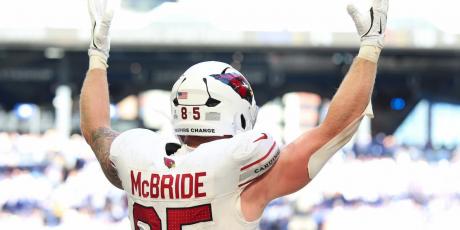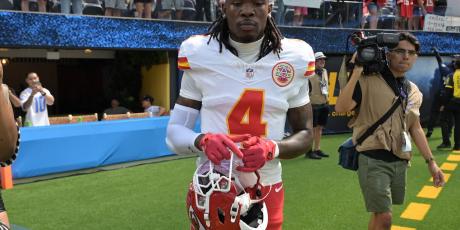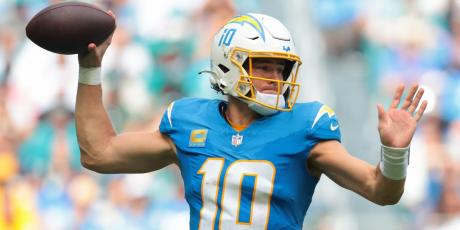9 Strategies to Beat the NFL Player Prop Market
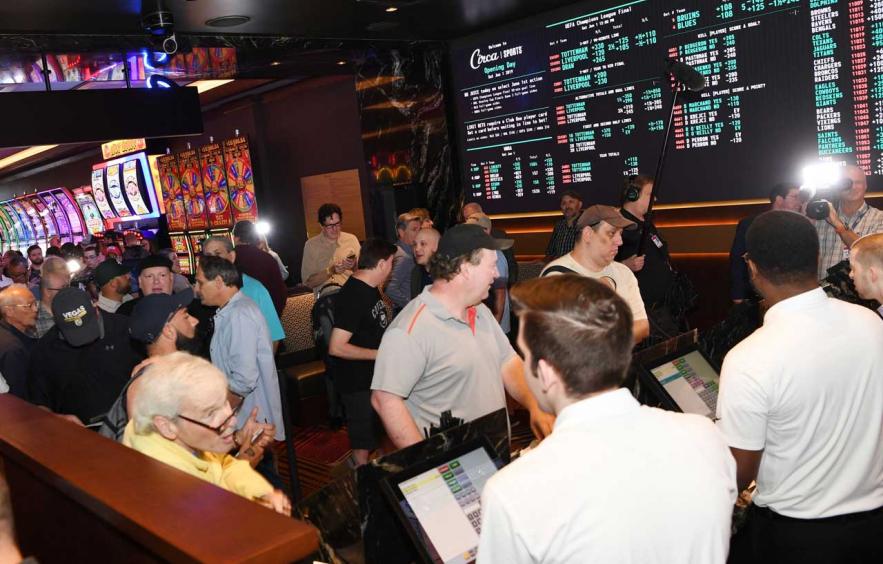
Along with the widespread legalization of sports betting, the player prop market has grown substantially—sportsbooks are offering thousands of different markets every NFL Sunday. Outside of sides and totals, books receive the most action on player props.
I’ve been wanting to write an article like this for a while, sharing my knowledge of what I’ve learned about betting on NFL player props, how you can gain an edge, and how to give yourself the best chance to win in the long run. I enjoy releasing player prop bets on 4for4 and helping others win money but one of our goals at 4for4 is to help make subscribers smarter and allow them to make sharper decisions by themselves. I believe we have the tools and knowledge to do so. If you just want picks, check out this article instead with all of our NFL futures bets.
For the past four years, I have written a weekly column breaking down my favorite NFL player props. I have been betting them personally for a lot longer. What started as something I did for fun quickly turned into a profitable side-hustle and eventually a full-time job here at 4for4. I have won above a 58% clip each of the past four years and all of my bets over the past two years are documented here by the one and only Dan Rivera. I have seen modest returns of 35+ units each of the past two seasons. There will always be cappers out there citing they won triple that in a single season or had a perfect week, and kudos to them. There is no better feeling than winning. A lot fewer people are able to show positive results for multiple years without any gaps and back that up with a consistent process. Don’t get me wrong, I have losing weeks and there are plenty of other great player prop handicappers and services out there. It’s just worth noting that transparency isn’t always a given in this industry.
All of my plays are released through our subscriber Discord and playable at the time of release. I cite the book, odds, and how many units I would risk to win, along with a write-up of why I’m betting it. I don’t front-run any of my bets and won’t bet into a flagged account to trigger an immediate move. I’m not going to lie to you and tell you I have all the answers, but below are some strategies I use to handicap the player prop market.
NFL Player Prop Betting Strategies
With betting NFL Player props there is no end-all-be-all. It’s cliché, but all the different strategies I use are just pieces of the puzzle. Relying on just one of these strategies usually leads to poor processes and, in the long term, poor results.
1. Leverage Projections
This is by far the easiest way to get started betting on player props and is one of the best ways to identify a potential bet. Compare good projections to sportsbook lines. If there is a big difference, it could be worth exploring more and potentially betting. Sportsbooks set thousands of lines per week, making it difficult to be super accurate on every single line.
There are multiple fantasy and betting analysts whose player projections are better than the opening player prop lines. I’m biased towards our projections here at 4for4 as John Paulsen and the team can claim to have “The Most Accurate Projections over the past 10 years.” The claim compares our projections to others in the fantasy industry but it rings true for betting purposes as well. We have a proprietary model that helps guide us in our initial projections and John hand-adjusts every player's projection, every week.
One of my first requests to our data scientist Sam Hoppen was to make the process of comparing our projections to sportsbook player props lines a little less tedious. He was able to do just that, building a tool that scrapes sportsbook player props and compares them to our projections. It automatically finds the best line and tells you how much of an edge our projections suggest. You can find the tool here.
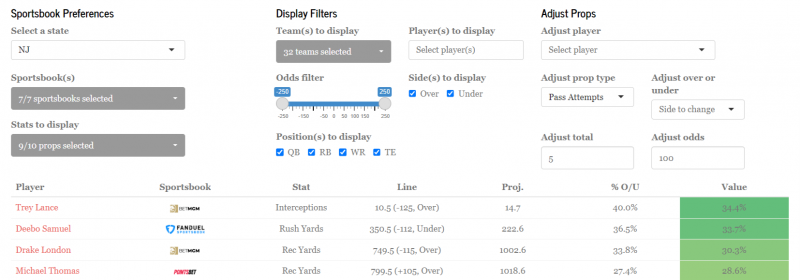
Multiple times per week I will look at that tool to see what our model believes are the biggest edges. While I don’t blindly bet the top values, editor and producer Sal ran a segment on Move The Line’s Prop Drop show last season where he picked one of the top bets from the tool each week without any other research and was very profitable in doing so.
Beyond using the tool, I lean on our projections throughout the week when deciding when to make a bet. If the projections vehemently disagree with my thesis stemming from other betting strategies, I might pass on the bet instead of playing it.
2. Analyze Matchups
Matchups matter, to an extent. I like to look at the extremes because that’s when matchups tend to matter the most. Top-five and bottom-five numbers are worth looking at trying to exploit. If a team's metrics are towards the middle it makes it less actionable because the projected edge likely isn't as significant.
If you are going to analyze a matchup, use a blend of efficiency metrics. Expected Points Added (EPA), explosive pass/run rate, and success rate are all good places to start. Simply citing a team’s rushing or passing yards per game allowed can provide some misleading results. Among other things, It doesn’t factor in a team's run/pass ratio or the game script.
After analyzing matchups by hand (Excel) for years we now have a tool that allows you to easily compare each team’s most important metrics here under the matchups tab.

3a. Shop For the Best Line
Having access to multiple sportsbooks and comparing odds from book to book is very important when betting in general but especially for player props. For NFL spreads and totals you can usually shop around and find a half-point better, or maybe a full point if you are lucky. NFL player props can be 10-15% off from one another. Getting a better line or even better juice helps to increase your long-term profit. The people who say “juice doesn’t matter if you don’t lose” don’t understand the concept of expected value.
When you do lose, would you rather lose $125 or $130? A $5 difference may not matter to you this week but even a slight difference like that repeated for 20 weeks is an extra $100. In this scenario that’s an entire unit more you will be up, just by wagering on the better odds.
If you know which player you want to bet on, use the player prop finder, where you can search for any player’s props across any sport.
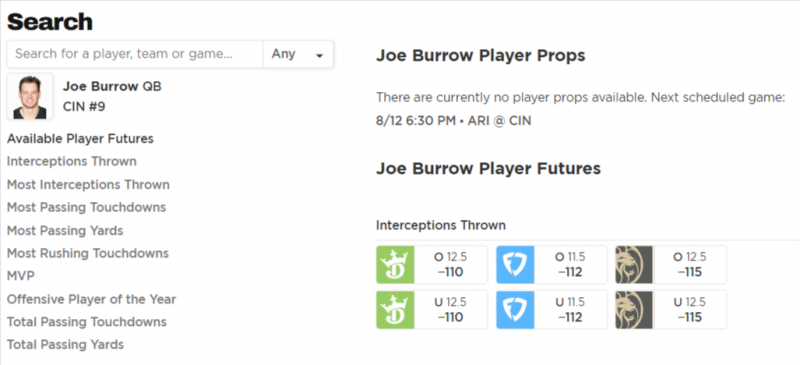
3b. Analyze Market differences
I did a thread on this for season-long player props and will be doing a weekly thread every Saturday analyzing the most significant differences from book-to-book in the player prop market. This can help to identify bad lines and potentially create bets you normally wouldn’t bet but with additional value you are interested in. We are updating this tool for in-season props that will scrape all of the odds from different sportsbooks and allow you to easily compare them by category.
One of the easiest ways to beat the market in sports betting is to compare odds from different sportsbooks and pinpoint value.
I found 7 significant differences in NFL season-long players props you can take advantage of 🧵⬇️
— Connor Allen (@ConnorAllenNFL) July 15, 2022
4. Comprehend the Frequency of a Bet Winning or Losing
A question I like to ask myself when handicapping a player prop is, “How often has a player actually hit this number?”
It's oftentimes simple for an analyst to look at a player’s easy matchup plus a strong projection and think the over is an easy bet. Yet looking at the frequency can help paint a different picture.
For example, say player X has a reception line of 4.5. He has a great matchup and his projection is over 4.5 at 4.9. Yet, he has only gone over 4.5 receptions in just 3-of-10 games so far this season.
Why is that? His not hitting the number doesn’t necessarily make this a bad bet but should help you explore why he hasn’t hit those numbers in previous weeks. It should also challenge your thought process on why you believe you not only have an edge on betting his over but also have a significant edge. Again, this is just another benchmark, not an end-all-be-all.
We built a tool that provides an easy visual of how often a player is hitting a bet.
That being said, this type of analysis can be incredibly noisy when applied incorrectly. Don’t just pick a random sample of games without a reason. Blindly citing a player going over or under a prop in three of the last four games when there is a larger available sample usually leads to meaningless analysis. There are reasons it could make sense to hand-pick a smaller sample size such as a player’s role changed (more routes, carries, targets, etc.), a teammate got injured, or those games are for some reason anticipated to be similar to this one (high scoring, heavy favorite, etc). My word of advice is to be careful and try to understand the context behind why a chosen sample could matter. If there isn’t one, ignore it.
5a. Understand Player Usage
Usage is the most important facet of understanding how to predict a player's range of outcomes and something that the fantasy community has gotten relatively good at projecting and understanding. Transferring that to betting isn’t too difficult.
Say you want to analyze a player's reception prop. I like to look at metrics and data such as targets, target share, average depth of target, snap share, and air yards. All of those are reasonably helpful metrics to help understand a player’s role as a wide receiver. Good projections already factor in all the aforementioned metrics and are the main reason it’s easier to start betting player props by using projections.
5b. Take Advantage of Changing Circumstances
Where you can take advantage of understanding roles and usage is when a player's situation changes. Once you understand players' roles you can make quick bets when another player gets injured, traded, suspended, etc. An offseason example is Russell Gage. All offseason he was slotted in as the clear No. 2 target for Tom Brady while Chris Godwin was expected to open the season on the PUP list and miss the first 4-6 games. The Buccaneers then signed Julio Jones and hours later it was announced Chris Godwin was well ahead of schedule and likely on pace to play in Week 1. So how does this impact Russell Gage? It certainly reduces his projected week-to-week target share and makes him the third or fourth option. This is a pretty drastic change from our original expectations. As soon as we heard the news, our team at 4for4 was able to bet his under at 725.5 receiving yards—it’s now at 575.5. Does it completely kill his output? Probably not. But it certainly lowers his target floor and ceiling. This is just one example and there are plenty of opportunities like this on a week-to-week basis with injuries.
Word of caution in-season: If the starter goes down, it is usually easier to project backup running back touches than backup pass-catcher targets. Target shares wind up a lot more volatile and just because a player is running routes it doesn’t mean he’ll see much work. It’s not very novel but I’m of the belief targets are earned by being a good wideout and getting open. Most bench players simply aren’t good enough to step into the starting lineup and produce or don’t have the necessary chemistry with the quarterback to succeed. Whereas backup running backs get the ball handed to them.
6. Know which Reports Matter
Many members of the media are very good at reporting what is going on with a player’s status (likely/not likely to play) but are very, very bad at projecting usage and roles. We will hear plenty of “Player X is going to see 20 carries per game!” Yet everyone gets pissed when they end up with 12 carries and are in a timeshare. Without fail, a scenario happens like this multiple times a year. Repurposing a popular phrase from the financial field, buy the report, sell the projection.
7. Use Sportsbook Lines and Totals as a Guide
NFL Closing lines are one of the most efficient markets in all of sports betting. Using those to understand which teams are likely to win, score a lot, or vice versa can help guide your bets.
For example, do you really want to smash the rushing yards over of a running back who is a 10-point road underdog? Maybe it’s a great matchup, but the most efficient market in sports betting is saying this team is going to play from behind most of the game. Nearly every team throws more when they are playing from behind. Meaning that running back could see only a few touches as the game is winding down or even get benched if they get blown out. It just makes the bet a lot thinner and more has to go right for your bet to hit.
We have a free tool that makes it easy to compare all the spreads, totals, and Moneylines.
8. Get Comfortable with Betting Unders
I did a thread on this for season-long player props and the results were staggering. Unders hit 66.6% of the time on season-long props on the 243 props I was able to get from last season.
Sportsbooks have posted hundreds of NFL season-long player props for 2022 already.
I analyzed 243 props from last season and found 5 interesting trends that will help you win money betting them this year 🧵⤵️
— Connor Allen (@ConnorAllenNFL) July 5, 2022
Betting the under isn’t quite as powerful on in-season props but multiple studies have been done showing it is almost always the right lean and skewing the majority of your bets towards the under usually helps to tilt the odds in your favor. That being said, some people have better success with overs.
9. Bet Into the Market Early, Often, and Quickly
Lines move, fast. The player prop market isn’t liquid as sides or totals and sometimes props can move significantly or get pulled when they are taking too much action. Lines are also softest when they are just released, so if you don't take advantage of them as soon as you see them, there's a good chance someone else will. After bettors shape the market, it becomes more efficient as lines move.
This article is intended for entertainment purposes and adult users only. Call 1-800-GAMBLER if you have a gambling problem


